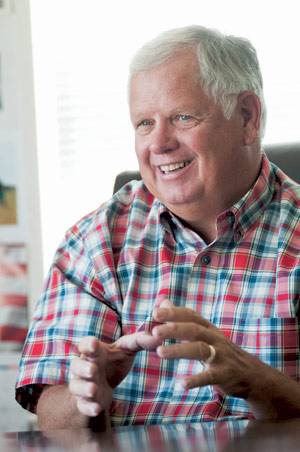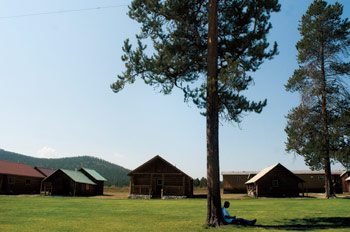The young man is all smiles until he’s tied in and walking backward toward the cliff. Morning sunshine warms the 90-foot sheer rock wall near Kila, and his bravado flickers and falters as his heels run up against the edge.
His white T-shirt begins to rise and fall quickly, his chest heaving with anxious breath. Tan forearms with lean muscle flexing flow into gloved hands, grabbing the rope anchoring him to sturdy, steadfast trees.
He is scared, but that is the point. He is here to be overwhelmed by what it feels like to be on the edge of a precipice, to choose to go over the lip of the cliff and trust that he won’t fall, that he will stay harnessed to the earth and that he will make it down.
A nervous smile now, he moves his legs again under the gentle-but-firm direction of the bearded man to his left. His back to the sun, the young man steps from flat ground into the air.
“I went to the woods because I wished to live deliberately, to front only the essential facts of life, and see if I could not learn what it had to teach, and not, when I came to die, discover that I had not lived.” – Henry David Thoreau
When we are born, we are clean slates to be enhanced and marred by the world. Each person faces his or her own challenges, trying to make it through with the tools they are given and the choices they make, and yet, sometimes that isn’t enough.
Sometimes people need help getting back on track.
John Brekke understands this concept well, and believes that for just about anyone, the answer to problems in increasingly complicated lives lies in the simplicity of nature.
This is the basis of the Wilderness Treatment Center, a rehabilitation facility in Marion that has been treating boys and young men aged 14 to 24 for 30 years.
The eight young men gathered on the Kila cliffs last week were participating in one of the Wilderness Treatment Center’s therapeutic exercises, or “opportunity teaching,” Brekke explained in his office on the reformed dude ranch that was built in the 1920s. They were working on the third of the 12 steps, which involves turning their lives over to a higher power.
Wilderness Treatment Center was the first of what is now a popular rehab method, Brekke said, a marriage of the 12-step addiction recovery process and building self-esteem through surviving and thriving in nature. The young men here spend the first 30 days in Marion in treatment, followed by an intense trip to the wild for 16 or 21 days, depending on the season.
“Most programs use wilderness as the intervention,” Brekke said.
His program teaches these young men how to be sober, then how to build confidence by going on a backcountry trip in the Bob Marshall Wilderness Complex with an outfitter permit the center acquired three years ago.
“Going in the woods is a reward,” Brekke said.
Brekke and his wife, Nancy, founded Wilderness Treatment Center in 1983 after he had spent six years with the Swan River Youth Camp, testing out a wilderness program with prison inmates.
 |
|
Sitting in his office, John Brekke, founder and CEO of the Wilderness Treatment Center, talks about the center’s beginnings. – Lido Vizzutti | Flathead Beacon |
“I made the decision that I wanted to do it completely my way,” Brekke said.
He was baffled that no one had put the 12-step and outdoors excursion models together before, and knew his home state of Montana had the right ingredients to make it a successful combination.
“We’re just in the greatest spot in the world to do this,” Brekke said.
Most rehab centers help a patient through the first five steps, Brekke said, and the young men in his care are taught the same. They must be on the third step before they can go on a trip, though.
“The trip’s much easier if you’re willing (to turn your life over to a higher power),” he said. “Their willingness gets them out there.”
Of course, safety is of utmost importance at WTC. It is licensed and monitored by the state Department of Public Health and Human Services and accredited by the National Association of Therapeutic Schools and Programs. WTC employs qualified medical and psychological personnel. With these oversights in place, insurance can cover the $425-per-day cost, Brekke said.
The program has never had a death in its 30 years of operation, Brekke notes, though there have been injuries to counselors and patients while out in the wilderness. That’s one of the risks of going into the backcountry, he said, but it’s also one of the reasons the trip can be so rewarding for these young men.
“There’s just something about really and truly going beyond the trailhead,” Brekke said.
There are shouts of encouragement from the young man’s companions on the cliff, eight of them total. He is moving slowly, his back nearly parallel to the ground far below him, his yellow helmet sticking out from the cliff as though he is a stubborn plant used to thriving in unusual places.
About 10 feet down from the edge of the cliff, his progress is halted and he dangles in the air, feet against rock. His counselor above – Mark Lyga, one of WTC’s clinical directors – tells him to let go of the rope, to put his hands out to his sides and trust that the rope will hold.
“When you let go of the rope, what are you really letting go of?” the counselor asks.
“I’m letting go of my resentment,” the young man answers.
“Louder,” the counselor says.
The young man repeats himself in a shout, which echoes off the cliff face and settles in the fields behind and below him. A cheer erupts from those watching from the cliffs above.
 |
|
A Wilderness Treatment Center resident writes in the shadow of a tree at the treatment center’s property near Marion. – Lido Vizzutti | Flathead Beacon |
“It is not so much for its beauty that the forest makes a claim upon men’s hearts, as for that subtle something, that quality of air, that emanation from old trees, that so wonderfully changes and renews a weary spirit.” – Robert Louis Stevenson
Most of the young men sent to the Wilderness Treatment Center are troubled when they arrive there. Ninety percent are from out of state, and are not accustomed to a world of fields, trees, cabins and no electronics.
“They are out of their element and uncomfortable,” Brekke said. “All of a sudden, they have to listen.”
This makes them more vulnerable to the staff’s suggestions. It’s a simple but structured world, with Monday through Thursday spent in therapy from 9 a.m. to 8:30 p.m. Fridays and Saturdays are work days, filled with chopping wood, feeding cows, fixing fence, cleaning the kitchen and cabins, and, for some of the toughest patients who seem to have trouble opening up, bottle-feeding calves.
Sunday is for recreation, with rappelling, hiking, rock climbing, Frisbee golf, basketball, and cross country skiing in the winter.
Structure is necessary for these young men, Brekke said, because they’ve come from a world where they’ve had none and have typically ruined nearly all aspects of their lives.
“It’s a serious illness,” Brekke said of addiction. “It needs a lot of attention.”
Consequences are part of life for WTC residents as well; for example, three young men who were four minutes late for a mandatory activity were disciplined by having to strip the bark off logs after lunch.
But most times, nature takes care of any punishments, Brekke said. If a resident chooses to leave his boots outside overnight, despite being told it’s a better idea to keep them indoors, he has to live with the consequences if they get drenched in a rainstorm or chewed on by a curious squirrel.
WTC is also a working cattle ranch, with 4,000 acres for the 100-head herd to wander in the summer. In the winter, the young men feed the cattle with hay grown and bucked by summer residents. Two cows are butchered each month to provide beef for the center.
“It’s a circle-of-life type thing,” Ben Dorrington, the director of referral relations and a licensed addiction counselor, said while introducing some visitors to Betty, the skittish resident calf.
Everything at WTC is part of a larger process. The third step leads to the fourth, which residents confront while on a three-day solo trip during their wilderness expedition. It involves taking an honest and fearless personal inventory of their assets and liabilities, written out in a 28-page document.
The fifth step is for the residents to take on their own, Brekke said. They meet with a minister, to tell a higher power and another human being the exact nature of their past wrongs.
One of the residents on the rappelling trip to the Kila cliffs, 31 days sober, said he has been to many treatment centers around the U.S., and this one was by far the best. It has been a life-changing experience, he said.
After roughly 60 days in Marion, the young men receive aftercare and typically are sent to other structured programs, such as therapeutic boarding schools or halfway houses.
“They’re not fixed when they leave here,” Brekke said. “They need more. You can’t just put ‘em back out there.”
Wilderness Treatment Center keeps track of its former residents, checking in at six months, a year and two years post-rehab. Brekke said the center strives for total abstinence, and about 75 percent of the young men who make it through the 60 days in Marion are still sober a year later.
The young man is picking up speed now on his descent, his nervous smile replaced by one of sheer happiness. His companions above hoot and holler as he plants his feet firmly against the rock and pushes off, lifting himself into the air.
Finally he drops to the ground, unties himself from the rope and begins the climb back up to the cliff’s edge. It is work – it’s always work getting back up. But he is still invigorated by the experience of going over the dangerous edge, one that empowered him instead of hurt him.
At the top of the gravely chute he has just climbed, he walks back to the other young men gathered on the rocks. Despite living through the addiction that got him here, he’s never experienced a high like this. How long the feeling lasts will be up to him, with a future of hard decisions ahead of him. But for now, he is sweating and smiling, happy and cleansed under a Montana September sky.